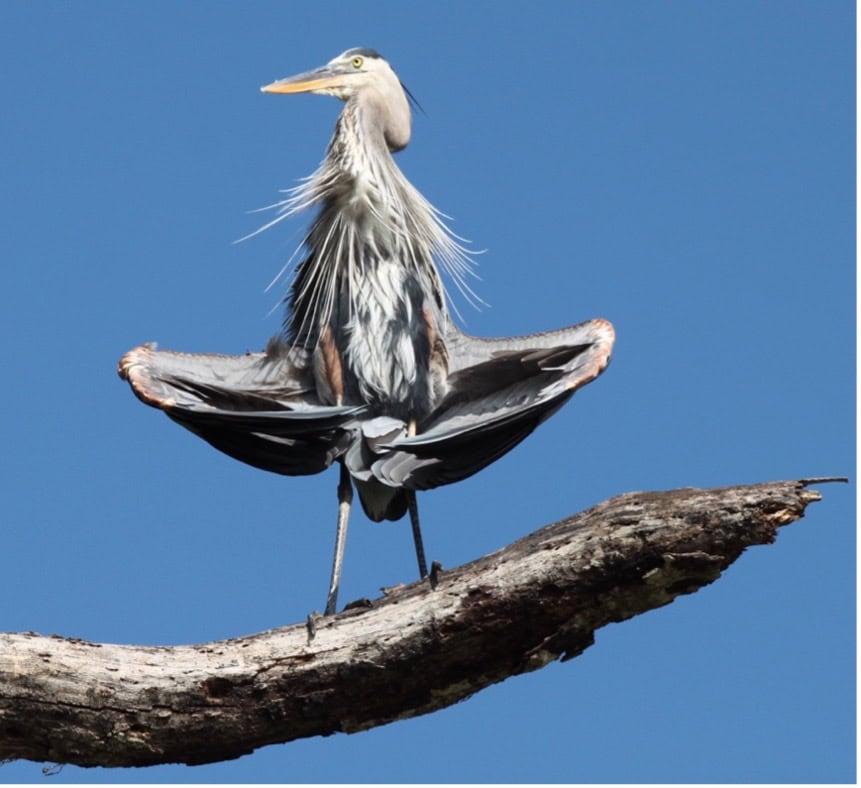
The Great Blue Heron: Verandah’s Majestic Sentinel
When you think of the birds that define Verandah’s ponds, the Great Blue Heron likely comes to mind. Towering and elegant, this bird is a common, yet awe-inspiring sight around the ponds and waterways of Verandah. Whether patiently hunting along the water’s edge or gliding overhead with slow, deliberate wingbeats, the Great Blue Heron commands attention.
Standing up to four feet tall with a wingspan that can exceed six feet, the Great Blue Heron is the largest heron in North America. Its plumage is predominantly slate-blue, with a long, sinuous neck and a dagger-like bill that is ideal for spearing fish. Adding to its regal appearance is a striking black plume extending from just above its eye to the back of its head.
Male and female herons look similar, though males are typically larger. During the breeding season, both sexes develop special plumes on their necks and backs, adding to their already dramatic look. Their courtship displays are equally impressive, with ritualized preening and neck-stretching.
Juvenile Great Blue Herons are more subdued in color, lacking the bold black plumes and displaying duller grayish-blue feathers. Watching a young heron practice fishing can be a delightful sight—they often fumble and jab at the water awkwardly before mastering the graceful precision of their elders.
Ten Facts About the Great Blue Heron:
1. The Great Blue Heron weighs only 5 to 6 pounds due to its hollow bones, a feature common in birds. Despite their large size, great blue herons are nearly silent in flight due to the special structure of their feathers, which reduces turbulence and noise, helping them sneak up on prey.
2. They are expert hunters, known for their patience and ability to strike with lightning-fast reflexes to catch fish, amphibians, reptiles, and even small mammals. They use two distinct hunting strategies—standing motionless and waiting for prey to come close or slowly stalking their target with deliberate steps before striking. Their necks have a specialized vertebra structure allowing them to coil like a spring and strike prey with lightning speed and precision.

3. Great Blue Herons can be found throughout North America, from Canada to the Caribbean, Central America, and even parts of South America. The Seminole tribe and other Native American groups in Florida regarded the heron as a symbol of patience, self-reliance, and resourcefulness.
4. They are highly adaptable and can live in both freshwater and saltwater habitats, including ponds, marshes, and estuaries.
5. In flight, they tuck their necks into an “S” shape, a distinguishing feature from cranes, which fly with necks outstretched.
6. Great Blue Herons are solitary hunters but often nest in colonies called rookeries, sometimes with hundreds of nests in one area. Their nests are large and built from sticks, often high in trees or shrubs near water; although in Florida, they may also nest in mangroves.
7. Great Blue Herons are skilled at regulating their body temperature in Florida’s heat by panting and using a behavior called “gular fluttering,” where they rapidly vibrate the throat muscles to cool down. They also hold their wings open to allow air to circulate through their body.
8. A heron’s diet is diverse and opportunistic—besides their primary diet of fish, they have been observed eating snakes, insects, baby alligators, and even other birds.
9. They are relatively long-lived for birds, with some individuals reaching over 15 years in the wild.
10. In Florida, the Great Blue Heron has a special color variation. This white morph, called the Great White Heron, is found mainly in southern Florida.
The Great Blue Heron is more than a striking figure; it’s a reminder of the beauty and balance of wetland ecosystems. Seeing one in Verandah is like stepping into a painting where patience and grace come to life. Take a moment to admire this bird the next time you see it standing statue-like in the shallows of our ponds—it’s a true emblem of Verandah’s natural splendor.






